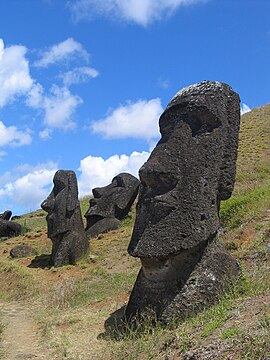
Back فن أوقيانوسيا Arabic Art d'Oceania Catalan Umění Oceánie Czech Arto de Oceanio Esperanto Arte de Oceanía Spanish Okeaania kunst Estonian هنر اقیانوسیه Persian Art d'Océanie French اقيانوسي هنر Pashto/Pushto Arte da Oceania Portuguese

| This article is part of a series on |
| Oceanian Culture |
|---|
 |
| Society |
| Arts and literature |
| Other |
| Symbols |
|
|
|
Oceania Portal |
Oceanic art or Oceanian art comprises the creative works made by the native people of the Pacific Islands and Australia, including areas as far apart as Hawaii and Easter Island. Specifically it comprises the works of the two groups of people who settled the area, though during two different periods. They would in time however, come to interact and together reach even more remote islands. The area is often broken down into four separate regions: Micronesia, Melanesia, Polynesia and Australia. Australia, along with interior Melanesia (Papua), are populated by descendants of the first waves of human migrations into the region by Australo-Melanesians. Micronesia, Island Melanesia, and Polynesia, on the other hand, are descendants of later Austronesian voyagers who intermixed with native Australo-Melanesians; mostly via the Neolithic Lapita culture. All of the regions in later times would be greatly affected by western influence and colonization. In more recent times, the people of Oceania have found a greater appreciation of their region's artistic heritage.
The artistic creations of these people varies greatly throughout the cultures and regions. The subject matter typically carries themes of fertility or the supernatural. Art such as masks were used in religious ceremonies or social rituals. Petroglyphs, Tattooing, painting, wood carving, stone carving and textile work are other common art forms. Contemporary Pacific art is alive and well, encompassing traditional styles, symbols, and materials, but now imagined in a diversity of contemporary forms, revealing the complexity of geographic, cultural and individual interaction and history.[1]
- ^ Brunt, Peter (2012). Art in Oceania: A New History. New Haven and London: Yale University Press. pp. 410–497. ISBN 978-0-300-19028-1.
© MMXXIII Rich X Search. We shall prevail. All rights reserved. Rich X Search